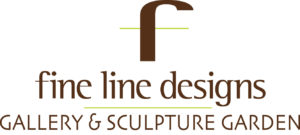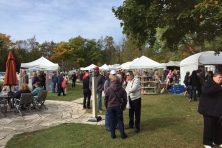What’s in Store at the Townline Art Fair
- Share
- Tweet
- Pin
- Share

This weekend’s Townline Art Fair (Oct. 7 and 8) will bring together the work of more than 75 selected artists and several thousand attendees. Located on the grounds of the Fine Line Design Gallery on state Highway 42 at the north end of Ephraim, the fair draws huge crowds to the lawn.
For visitors, this is an opportunity to see a wide variety of art in a casual outdoor setting, talk to the artists, buy if they want, and walk away if they aren’t interested. For many, the outdoor setting can be less intimidating than walking into a gallery.
For exhibiting artists, this is a chance to engage with potential patrons who might buy on-site or commission work, all in just two days. At least some of the exhibitors make most of their income from art fairs, where they pay fees for the space and often an entry fee, but they don’t split the sale with a gallery.
The fair is also a benefit to its organizer and host, Fine Line Designs Gallery. Through the entry process for the fair, gallery owner and curator Sheri Gransee gets to see a lot of artists who do fairs across the region. Several of the gallery’s artists are people she discovered through the fair. This year, the fair has quite a few new artists.
“I don’t just take people to take people, they have to be good,” she said. “It’s not all high-end art; craft is good too. I really try to jury the show to reflect what’s inside the gallery, to make them complementary. People discover us by coming to the art show, so I want what they see outside to draw them inside.”
Younger artists often use social media to sell their work, but she thinks they are missing something by not participating in art fairs.
“Fairs offer interaction with customers,” Gransee said. “I go to shows in New York and I build these personal relationships with artists I have been dealing with for years.”
Get to know a few of the artists who will be part of the show this weekend.
Brady Lueck, Sculptor
Brady Lueck was in Thailand helping install state-of-the art welding equipment at a shipbuilding college when he decided he’d learn welding himself. His company paid for two years of night classes at Gateway Technical College.
“I spent two years learning before I started my sculpture,” said Lueck, who had previously worked with ceramics. “I have been in the arts all my life and had worked with clay. I loved how fast and fluid it was, but it was too fragile and I wanted to do something with metal.”
He likes to make complex, high-end pieces that show his steel welding skills, but he also makes smaller, more affordable work.
Tom Lazar, Photographer

When he started as a professional photographer specializing in nature pictures, Tom Lazar expected to make most of his income from publications, either selling direct or through stock-photo agencies. Art shows would be a sideline.
“I used to have a few things in galleries, but doing art shows is my primary source of income,” he said. “I also have agencies which market my work for me, but that has taken a huge hit – you could not make a living just doing stock any more.”
He works with two agencies that specialize in nature photography, one in the UK and one in New York. In his early career, he sold a lot of Great Lakes images through New York agencies.
“Most of my income through the agencies now comes from Asia,” he said. “They like nature photography of the United States.”
Now he does art fairs on a regular basis.
“I had expected I would work for agencies and get out of art fairs, but it went the other way,” he said. “Last year was my best year ever because during the pandemic a lot of people had bought houses in the last two years, and they were flush with money. I thought this year would slow down quite a bit, but it has been pretty good, too.”
He offers prints in a wide variety of sizes.
“I probably carry far too much inventory because I want to have the right size for people,” he said. “In a show at Rochester Hills outside Detroit, everything was big – big framed canvases. But at Sioux City, Iowa, it was mostly smaller prints or unframed stuff. I pull a trailer to haul it all – that way when I get home, unpacking is as simple as unhitching the trailer.”
Stan Piepenburg, Ink drawings

Stan Piepenburg has been exhibiting his ink drawings at the Townline Art Fair since the mid-80s.
“That was before canopies and it rained,” he said. “You had to have plastic out there hanging over everything.”
The early shows were across the highway from Lambert’s, south of Sister Bay.
Originally his work, mostly landscapes and waterscapes, was stark black ink on white paper but more recent work adds color and occasional brush strokes, still always with ink.
“My ink drawings capture the contours and contrast of our world using various colored inks,” he said. “I try to capture the feeling of spaciousness and serenity while illustrating the simplicity of our world that many of us take for granted,” he says on his website. “My ink work ranges from the detailed line drawings to the stark winter landscapes where the skies are formed using a combination of inks, creating multiple hues that all of us observe at different times.
He works up to 40 x 60 inches for commissions, but for shows, the largest work he takes along will be about 20 x 60 inches, and he finds small pieces – 6 x 6 inches – sell well.
Joy Kruse, Jewelry
“Design is never good if the thoughts are forced,” writes Joy Kruse on her website. Her solution?

“I have always kept a very disorganized journal of these thoughts,” she said. “It’s a messy tally of my brain but it works. Somehow, that messy record of randomness flows out of my fingertips and into a sheet of silver or gold.”
Kruse has a love/hate relationship with art shows, and in her blog speculates that Van Gogh cut off his ear because he had to do an art show.
“I make my living as an artist,” said Kruse, who worked as an RN for 20 years while doing jewelry on the side. “I guess the best way to earn a living is an art fair, but I have mixed feelings because most are outside and it’s a pretty hard way to make a living if you have to depend on the weather in Wisconsin.”
Kruse’s work can be found at Lady Bug in Algoma and Two Bridges in Sturgeon Bay and she is looking for another gallery.




